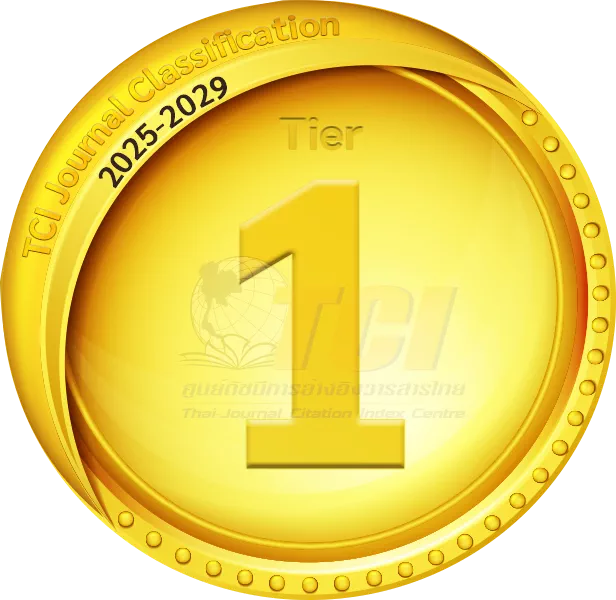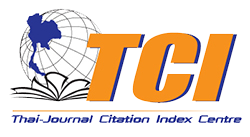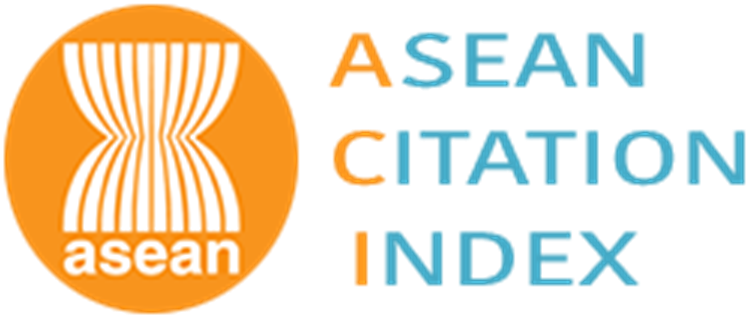ผลกระทบของสารลดแรงตึงผิวต่อกำลังอัดและความหนาแน่นของคอนกรีตผสมน้ำยางพารา
Reducing Unplanned Downtime Losses in the Shaft Assembly Process with Overall Effectiveness Measurement
Abstract
งานวิจัยนี้มีวัตถุประสงค์เพื่อศึกษาผลกระทบของสารลดแรงตึงผิวต่อกำลังและความหนาแน่นของคอนกรีตผสมน้ำยางพารา โดยเลือกออกแบบส่วนผสมคอนกรีตควบคุมกำลังอัด 240 กิโลกรัมต่อตารางเซนติเมตร และค่าการยุบตัวระหว่าง 7.5 – 12.5 เซนติเมตร ตัวอย่างทดสอบแบ่งออกเป็น 2 ชุด โดยชุดแรก น้ำในส่วนผสมคอนกรีตควบคุมบางส่วนถูกแทนที่ด้วยน้ำยางพาราในอัตราส่วนร้อยละ 0.5, 1.0, 1.5 และ 2.0 โดยน้ำหนักของน้ำ ส่วนชุดที่สอง นำส่วนผสมของชุดแรกมาแทนที่น้ำยางพาราบางส่วนด้วยสารลดแรงตึงผิวอัตราส่วนร้อยละ 5 โดยน้ำหนักของน้ำยางพารา หาค่าการยุบตัวขณะสดของคอนกรีตทุกส่วนผสม และทดสอบกำลังอัดที่อายุ 7, 14 และ 28 วัน ตามลำดับ ความหนาแน่นของคอนกรีตแต่ละตัวอย่างคำนวณจากน้ำหนักและปริมาตรรายก้อน จากการทดสอบพบว่า การเติมสารลดแรงตึงผิวช่วยให้คอนกรีตสดมีค่ายุบตัวสูงขึ้น และพบว่าการเติมสารลดแรงตึงผิวส่งผลให้คอนกรีตผสมน้ำยางพารามีกำลังอัดลดลงอย่างมากโดยเฉพาะในส่วนผสมที่มีน้ำยางข้นร้อยละ 1.5 และ 2.0 ซึ่งมีกำลังอัดลดลงสูงถึงร้อยละ 32 และ 57 ตามลำดับ เทียบกับคอนกรีตปกติ และพบว่าความหนาแน่นของคอนกรีตผสมน้ำยางพาราทั้งที่มีและไม่มีสารลดแรงตึงผิวแปรผันโดยตรงกับกำลังอัดอย่างมีนัยสำคัญ
This objective of this research is to study the effects of surfactant on compressive strength and density of para rubber latex concrete. Control concrete having compressive strength of 240 ksc and slump between 7.5 and 12.5 cm was chosen for the mix proportion design methods. Testing specimens was separated into 2 groups. The first group, a partial amount of water in control mixture was replaced by para rubber latex at rates of 0.5, 1.0, 1.5 and 2.0 percent by weight of water. The second group, 5 percent by weight of para rubber latex was replaced by surfactant for every mixture of the first group. For every mixture, slump of fresh concretes was observed. Compressive strength of each mixture was investigated at the ages of 7, 14, and 28 days, respectively. Density of each specimen was calculated using its weight and volume, one-by-one. It was found that surfactant could increase slump of fresh concrete. In addition, the surfactant resulted in a dramatic decline in the compressive strength of para rubber latex concrete, especially for the mixtures containing 1.5 and 2.0 percent of para rubber latex. Those mixtures showed decreases of 32 and 52 percent in comparison with the control concrete. Irrespective of surfactant, the density of para rubber latex concrete exhibits significant relationship with compressive strength of the specimens.
Keywords
[1] Yala Provincial Agriculture and Cooperatives Office. (2019, September). Important of para rubber latex. Yala provincial stocks report of 2019 “Para rubber latex”. Yala Provincial Agriculture and Cooperatives Office. Yala, Thailand. [Online] (in Thai). Available: https://www.opsmoac. go.th/yala-dwl-preview-412791791827
[2] E. Limsuwan, Column Analysis and Design I – II. Bangkok: Chulalongkorn University, 1993 (in Thai).
[3] P. Jidrada and B. Chatveera, “Effect of combined coal-biomass ash on the chloride penetration resistance of mortar cement: A case study of different anthracite, bituminous, rice husk and eucalyptus ash exposed to synthetic seawater,” KMUTT Research and Development Journal, vol.35, no.4, pp. 485-499, 2012 (in Thai).
[4] S. Siriphun, P. Boonnun, K. Loha, and A. Gamnerdvam, “Using natural rubber for development of concrete works,” Thailand Research Fund, Bangkok, RDG 4750047, 2005 (in Thai).
[5] J. Wongpa, S. Koslanant, W. Chalee, and P. Thongsanitgarn, “Effects of para rubber latex on workability, compressive strength and water permeability of normal strength concrete,” Mahasarakham International Journal of Engineering Technology, vol. 7, no. 6, pp. 61–66, 2021.
[6] P. Khampup, “Use of para-rubber to improve strength and insulation properties of autoclaved aerated lightweight concrete,” KMUTT Research and Development Journal, vol. 30, no. 2, pp. 363-376, 2007 (in Thai).
[7] P. Khamput, “Using of medium ammonia concentrated latex mixed in lightweight mortar,” The Journal of Industrial Technology, vol. 4, no. 2, pp. 49-56, 2008 (in Thai).
[8] C. Thongpin, S. Hemsri, P. Intarasanti, R. Khankrua, and S. Thaipitak, “Using of modified natural rubber to improve toughness of epoxy resin,” Thailand Research Fund, Bangkok, RDG 4850001, 2005 (in Thai).
[9] Standard Specification for Concrete Aggregates, ASTM C33/C33M-18, 2018. [10] S. S. Sahu and I. S. R. Gandhi, “Studies on influence of characteristics of surfactant and foam on foam concrete behaviour,” Journal of Building Engineering, vol.40, pp. 1–16, 2021.
[11] A. M. Neville and J. J. Brooks, “Permeability and durability,” Concrete Technology, 2nd ed. Harlow, England: Pearson, 2010, ch. 14, pp. 269–276.
[12] Standard Practice for Selecting Proportions for Normal, Heavyweight, and Mass Concrete, ACI 211.1-91 (Reapproved), 2002.
[13] Standard Test Method for Slump of Hydraulic-Cement Concrete, ASTM C143/ C143M-20, 2020.
[14] Standard Test Method for Compressive Strength of Cylindrical Concrete Specimens, ASTM C39/C39M-14, 2020.
[15] J. Bu, and Z. H. Tian, “Relationship between pore structure and compressive strength of concrete: Experiments and statistical modeling,” Sãdhanã, vol. 14, no. 3, pp. 337–344, 2016.
[16] G. Sukmak, P. Sukmak, S. Horpibulsuk, T. Yaowarat, K. Kunchariyakun, O. Patarapaiboolchai, and A. Arulrajah, “Physical and mechanical properties of natural rubber modified cement paste,” Construction and Building Materials, vol. 244, no. 12, pp. 1–10, 2020.
[17] J. Chen, M. Qiao, N. Gao, Q. Ran, J. Wu, G. Shan, S. Qi, and S. Wu, “Cationic oligomeric surfactants as novel air entraining agents for concrete,” Colloids and Surfaces A: Physicochemical and Engineering Aspects, vol. 538, pp. 686–693, 2018.
[18] M. Qiao, J. Chen, C. Yu, S. Wu, N. Gao, and Q. Ran, “Gemini surfactants as novel air entraining agents for concrete,” Cement and Concrete Research, vol. 100, pp. 40–46, 2017.
[19] G. Shan, S. Zhao, M. Qiao, N. Gao, J. Chen, and Q. Ran, “Synergism effects of coconut diethanol amide and anionic surfactants for entraining stable air bubbles into concrete,” Construction and Building Materials, vol. 237, pp. 1–9, 2020.
DOI: 10.14416/j.kmutnb.2022.09.002
ISSN: 2985-2145





